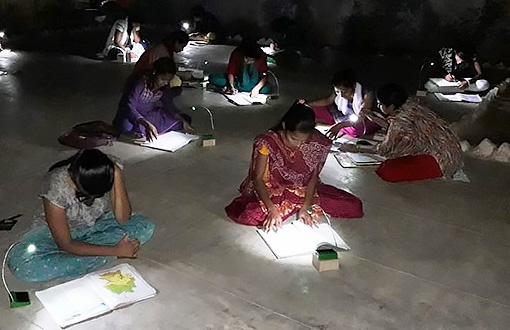This past spring, Unite to Light, the nonprofit founded by UCSB professor of electrical and computer engineering John Bowers, reached a major milestone by distributing its 100,000th solar-charged LED light with solar-charging battery pack to someone who lacks safe, reliable, bright light.
“Unite to Light is focused on getting light to those who could not otherwise afford it — children who are learning to read or need to study after dark, midwives — and also to health clinics and as part of disaster response,” said Unite to Light executive director, Megan Birney, in an article about the nonprofit published in the UCSB Current in 2017. “Supplying solar lights to midwives, refugees and new mothers falls squarely into our mission of providing tools for those in need so that they may have a better opportunity to survive and thrive.”
Since the nonprofit was founded in 2011, the lights have been distributed in more than 65 countries, including in Bangladesh, where they were given to Rohingya refugees — and especially pregnant women — fleeing violence in Myanmar, as well as in Puerto Rico shortly after Hurricane Maria cut out electricity on the island, and in Ghana, South Africa, Haiti, and Peru, to name several.
The lights are valuable to students who live in remote villages and may have only candles or kerosene-fueled lamp light after dark. In South Africa, high school students must pass the official school exit exam in order to graduate and have any chance of getting a job. In the nation's KwaZulu Natal region, where the unemployment rate is around 50 percent, pass rates for the critical exam have increased by twenty to thirty percent in areas where the lights were distributed.
In the United States, lights have also been distributed to people who spend the night in cars, targeting especially school children in that group so that they can do their homework at night. Lights have also been distributed in some native-American tribal areas that lack infrastructure.
"I’m proud of the job Megan Birney is doing as president of Unite to Light in expanding our connections in Haiti and South Africa,” said John Bowers in June while participating in a 2,745-mile unsupported bicycle ride from Canada to the Mexico border to raised funds for Unite to Light. “We are seeing a twenty- to thirty-percent increase in graduation rates with students who have lights. That means we’re helping an additional thirty thousand students graduate from high school, which is really, really exciting. Our next goal is one million lights!”
In order to ensure that the lights go to those who need them most, Unite to Light works only with reputable, knowledgeable local organizations who have years of on-the-ground experience.
“What I took for granted before I worked at Unite to Light was the extent to which a person’s life stops when the sun goes down, if they don’t have access to light,” Birney has said. “This is especially true for vulnerable populations. A simple solar light changes all that, giving people hours of extra time to do homework, fetch water, visit with family, or make dinner.”
Next up, Unite to Light will launch a program selling lights to entrepreneurs, who will then sell them to their countrymen who live in places without electricity. In the pilot projects, groups of women in Haiti and Zimbabwe who already sell health-care items will simply add the lights to their inventory. Unite to Light is also adding a new solar-powered charger battery bank that will charge cell phones and small electronics, such as tablets and fetal heart monitors.

Thanks to solar-powered LED lights from Unite to Light, these female students at a school in Umri, Maharashtra, India, are able to study comfortably after the sun goes down. Photo courtesy of Unite to Light

